cruise control CHEVROLET KODIAK 2009 Owners Manual
[x] Cancel search | Manufacturer: CHEVROLET, Model Year: 2009, Model line: KODIAK, Model: CHEVROLET KODIAK 2009Pages: 376, PDF Size: 5.39 MB
Page 4 of 376
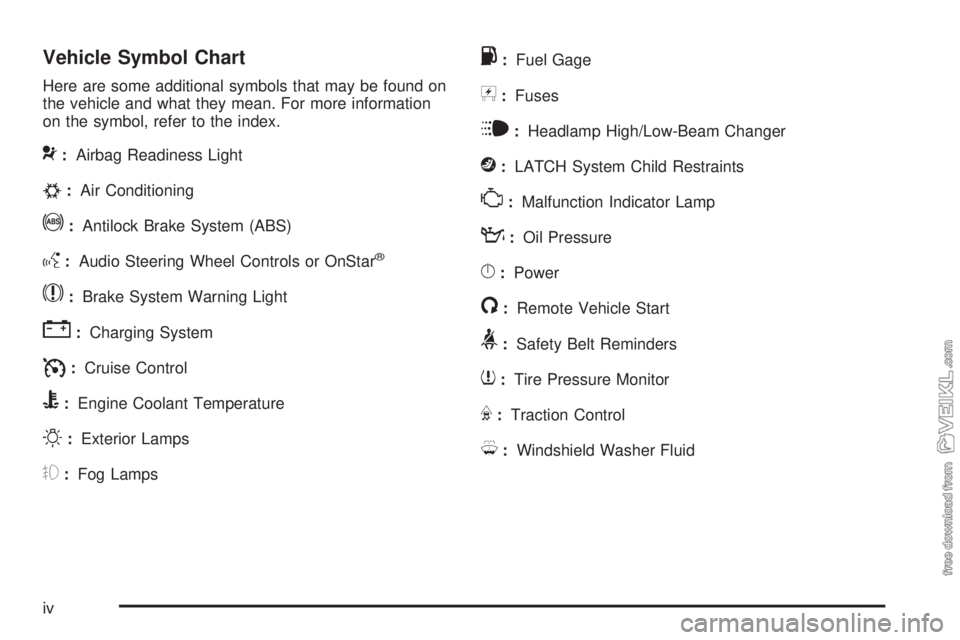
Vehicle Symbol Chart
Here are some additional symbols that may be found on
the vehicle and what they mean. For more information
on the symbol, refer to the index.
9:Airbag Readiness Light
#:Air Conditioning
!:Antilock Brake System (ABS)
g:Audio Steering Wheel Controls or OnStar®
$:Brake System Warning Light
":Charging System
I:Cruise Control
B:Engine Coolant Temperature
O:Exterior Lamps
#:Fog Lamps
.:Fuel Gage
+:Fuses
i:Headlamp High/Low-Beam Changer
j:LATCH System Child Restraints
*:Malfunction Indicator Lamp
::Oil Pressure
}:Power
/:Remote Vehicle Start
>:Safety Belt Reminders
7:Tire Pressure Monitor
F:Traction Control
M:Windshield Washer Fluid
iv
Page 90 of 376
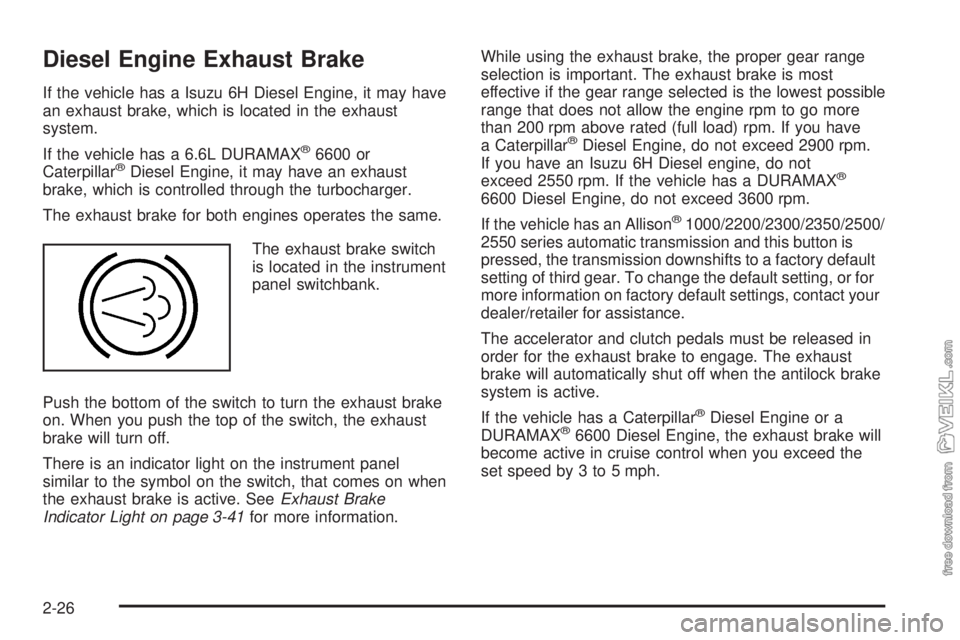
Diesel Engine Exhaust Brake
If the vehicle has a Isuzu 6H Diesel Engine, it may have
an exhaust brake, which is located in the exhaust
system.
If the vehicle has a 6.6L DURAMAX
®6600 or
Caterpillar®Diesel Engine, it may have an exhaust
brake, which is controlled through the turbocharger.
The exhaust brake for both engines operates the same.
The exhaust brake switch
is located in the instrument
panel switchbank.
Push the bottom of the switch to turn the exhaust brake
on. When you push the top of the switch, the exhaust
brake will turn off.
There is an indicator light on the instrument panel
similar to the symbol on the switch, that comes on when
the exhaust brake is active. SeeExhaust Brake
Indicator Light on page 3-41for more information.While using the exhaust brake, the proper gear range
selection is important. The exhaust brake is most
effective if the gear range selected is the lowest possible
range that does not allow the engine rpm to go more
than 200 rpm above rated (full load) rpm. If you have
a Caterpillar
®Diesel Engine, do not exceed 2900 rpm.
If you have an Isuzu 6H Diesel engine, do not
exceed 2550 rpm. If the vehicle has a DURAMAX
®
6600 Diesel Engine, do not exceed 3600 rpm.
If the vehicle has an Allison
®1000/2200/2300/2350/2500/
2550 series automatic transmission and this button is
pressed, the transmission downshifts to a factory default
setting of third gear. To change the default setting, or for
more information on factory default settings, contact your
dealer/retailer for assistance.
The accelerator and clutch pedals must be released in
order for the exhaust brake to engage. The exhaust
brake will automatically shut off when the antilock brake
system is active.
If the vehicle has a Caterpillar
®Diesel Engine or a
DURAMAX®6600 Diesel Engine, the exhaust brake will
become active in cruise control when you exceed the
set speed by 3 to 5 mph.
2-26
Page 119 of 376
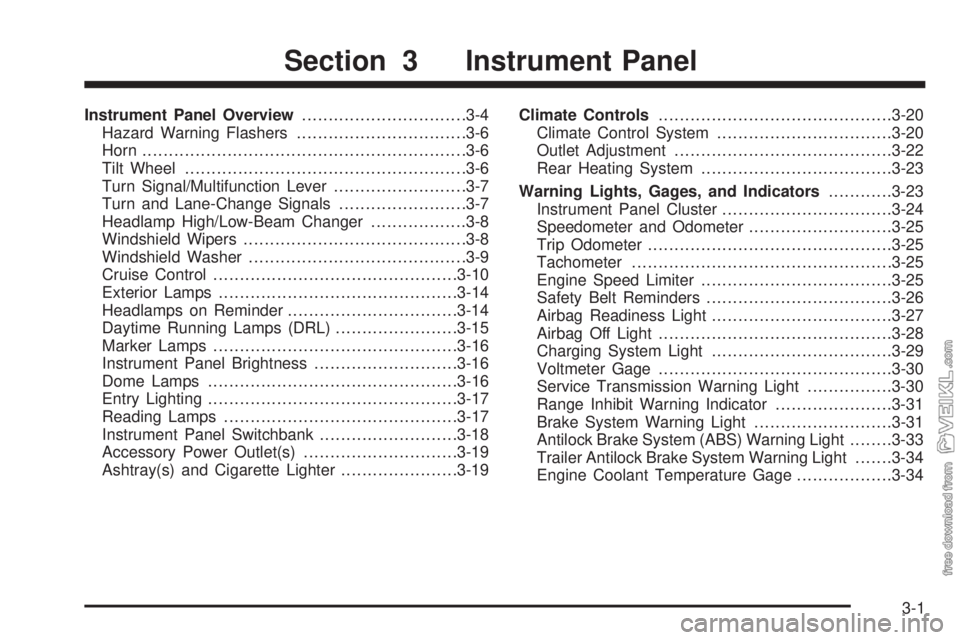
Instrument Panel Overview...............................3-4
Hazard Warning Flashers................................3-6
Horn .............................................................3-6
Tilt Wheel.....................................................3-6
Turn Signal/Multifunction Lever.........................3-7
Turn and Lane-Change Signals........................3-7
Headlamp High/Low-Beam Changer..................3-8
Windshield Wipers..........................................3-8
Windshield Washer.........................................3-9
Cruise Control..............................................3-10
Exterior Lamps.............................................3-14
Headlamps on Reminder................................3-14
Daytime Running Lamps (DRL).......................3-15
Marker Lamps..............................................3-16
Instrument Panel Brightness...........................3-16
Dome Lamps ...............................................3-16
Entry Lighting...............................................3-17
Reading Lamps............................................3-17
Instrument Panel Switchbank..........................3-18
Accessory Power Outlet(s).............................3-19
Ashtray(s) and Cigarette Lighter......................3-19Climate Controls............................................3-20
Climate Control System.................................3-20
Outlet Adjustment.........................................3-22
Rear Heating System....................................3-23
Warning Lights, Gages, and Indicators............3-23
Instrument Panel Cluster................................3-24
Speedometer and Odometer...........................3-25
Trip Odometer..............................................3-25
Tachometer.................................................3-25
Engine Speed Limiter....................................3-25
Safety Belt Reminders...................................3-26
Airbag Readiness Light..................................3-27
Airbag Off Light............................................3-28
Charging System Light
..................................3-29
Voltmeter Gage............................................3-30
Service Transmission Warning Light................3-30
Range Inhibit Warning Indicator......................3-31
Brake System Warning Light..........................3-31
Antilock Brake System (ABS) Warning Light........3-33
Trailer Antilock Brake System Warning Light.......3-34
Engine Coolant Temperature Gage..................3-34
Section 3 Instrument Panel
3-1
Page 125 of 376
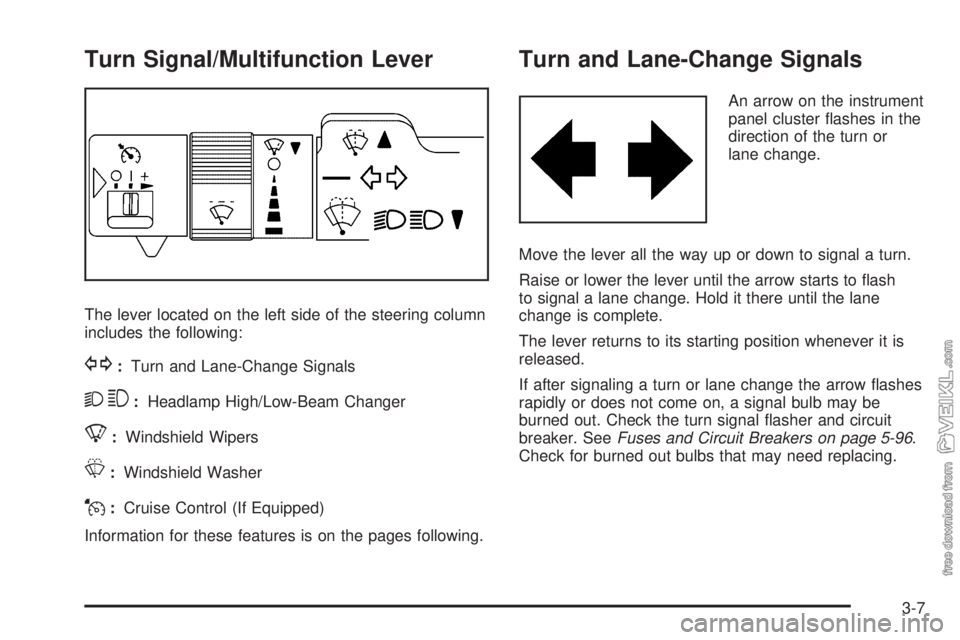
Turn Signal/Multifunction Lever
The lever located on the left side of the steering column
includes the following:
G:Turn and Lane-Change Signals
23:Headlamp High/Low-Beam Changer
8:Windshield Wipers
L:Windshield Washer
J:Cruise Control (If Equipped)
Information for these features is on the pages following.
Turn and Lane-Change Signals
An arrow on the instrument
panel cluster flashes in the
direction of the turn or
lane change.
Move the lever all the way up or down to signal a turn.
Raise or lower the lever until the arrow starts to flash
to signal a lane change. Hold it there until the lane
change is complete.
The lever returns to its starting position whenever it is
released.
If after signaling a turn or lane change the arrow flashes
rapidly or does not come on, a signal bulb may be
burned out. Check the turn signal flasher and circuit
breaker. SeeFuses and Circuit Breakers on page 5-96.
Check for burned out bulbs that may need replacing.
3-7
Page 128 of 376
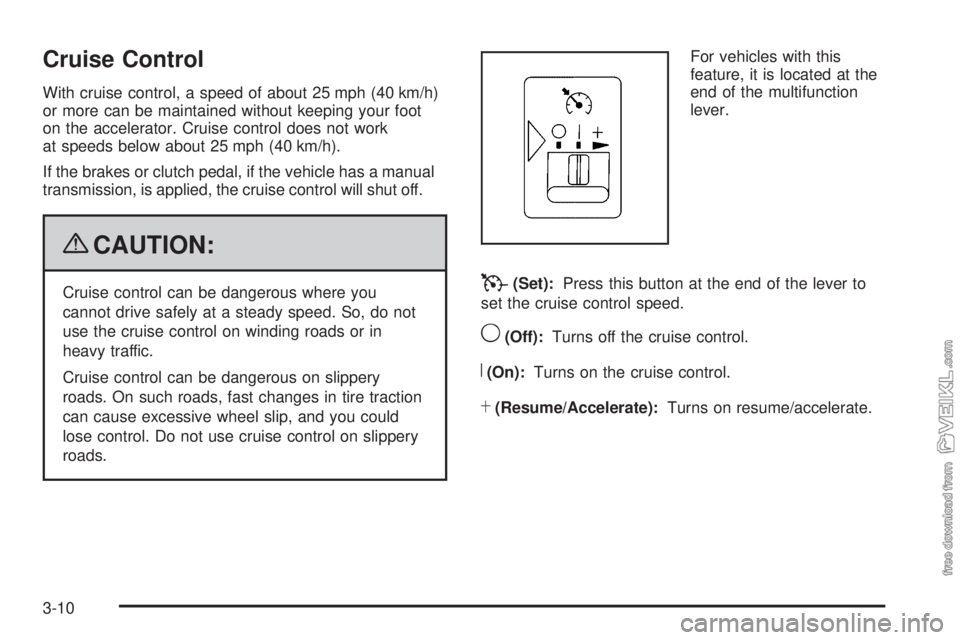
Cruise Control
With cruise control, a speed of about 25 mph (40 km/h)
or more can be maintained without keeping your foot
on the accelerator. Cruise control does not work
at speeds below about 25 mph (40 km/h).
If the brakes or clutch pedal, if the vehicle has a manual
transmission, is applied, the cruise control will shut off.
{CAUTION:
Cruise control can be dangerous where you
cannot drive safely at a steady speed. So, do not
use the cruise control on winding roads or in
heavy traffic.
Cruise control can be dangerous on slippery
roads. On such roads, fast changes in tire traction
can cause excessive wheel slip, and you could
lose control. Do not use cruise control on slippery
roads.For vehicles with this
feature, it is located at the
end of the multifunction
lever.T(Set):Press this button at the end of the lever to
set the cruise control speed.
9(Off):Turns off the cruise control.
R(On):Turns on the cruise control.
S(Resume/Accelerate):Turns on resume/accelerate.
3-10
Page 129 of 376
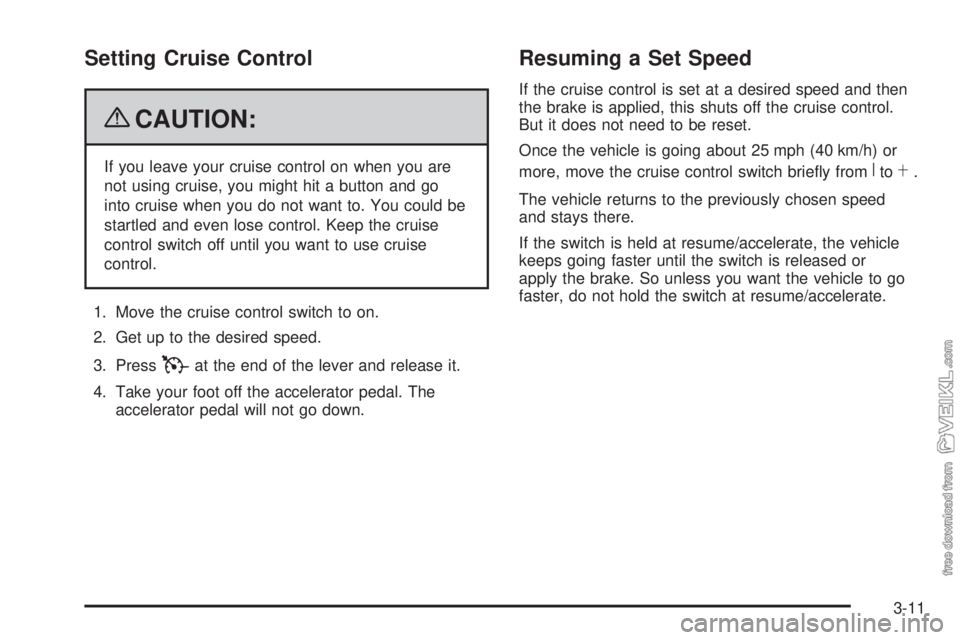
Setting Cruise Control
{CAUTION:
If you leave your cruise control on when you are
not using cruise, you might hit a button and go
into cruise when you do not want to. You could be
startled and even lose control. Keep the cruise
control switch off until you want to use cruise
control.
1. Move the cruise control switch to on.
2. Get up to the desired speed.
3. Press
Tat the end of the lever and release it.
4. Take your foot off the accelerator pedal. The
accelerator pedal will not go down.
Resuming a Set Speed
If the cruise control is set at a desired speed and then
the brake is applied, this shuts off the cruise control.
But it does not need to be reset.
Once the vehicle is going about 25 mph (40 km/h) or
more, move the cruise control switch briefly from
RtoS.
The vehicle returns to the previously chosen speed
and stays there.
If the switch is held at resume/accelerate, the vehicle
keeps going faster until the switch is released or
apply the brake. So unless you want the vehicle to go
faster, do not hold the switch at resume/accelerate.
3-11
Page 130 of 376
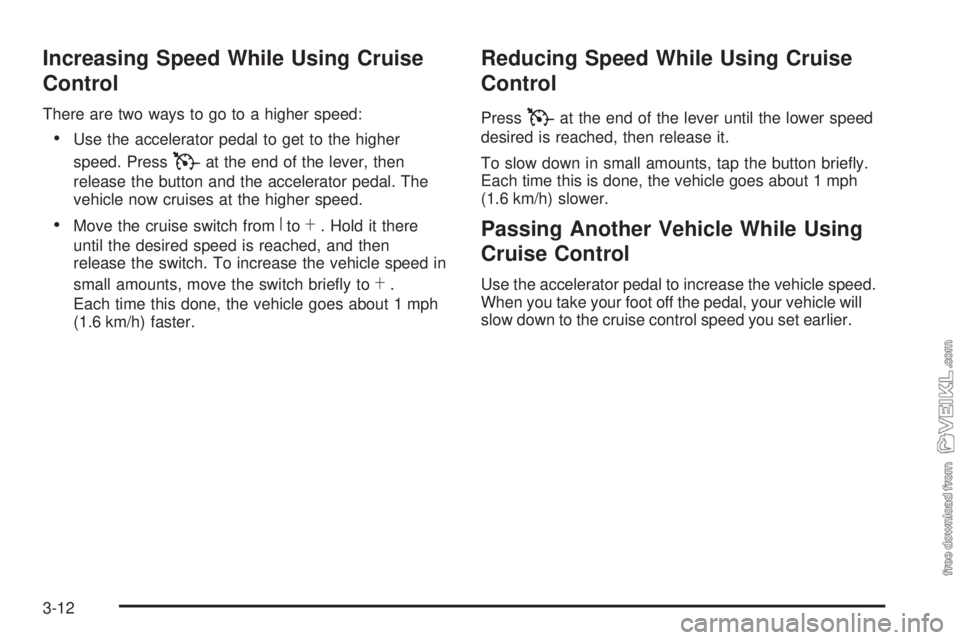
Increasing Speed While Using Cruise
Control
There are two ways to go to a higher speed:
•Use the accelerator pedal to get to the higher
speed. Press
Tat the end of the lever, then
release the button and the accelerator pedal. The
vehicle now cruises at the higher speed.
•Move the cruise switch fromRtoS. Hold it there
until the desired speed is reached, and then
release the switch. To increase the vehicle speed in
small amounts, move the switch briefly to
S.
Each time this done, the vehicle goes about 1 mph
(1.6 km/h) faster.
Reducing Speed While Using Cruise
Control
PressTat the end of the lever until the lower speed
desired is reached, then release it.
To slow down in small amounts, tap the button briefly.
Each time this is done, the vehicle goes about 1 mph
(1.6 km/h) slower.
Passing Another Vehicle While Using
Cruise Control
Use the accelerator pedal to increase the vehicle speed.
When you take your foot off the pedal, your vehicle will
slow down to the cruise control speed you set earlier.
3-12
Page 131 of 376
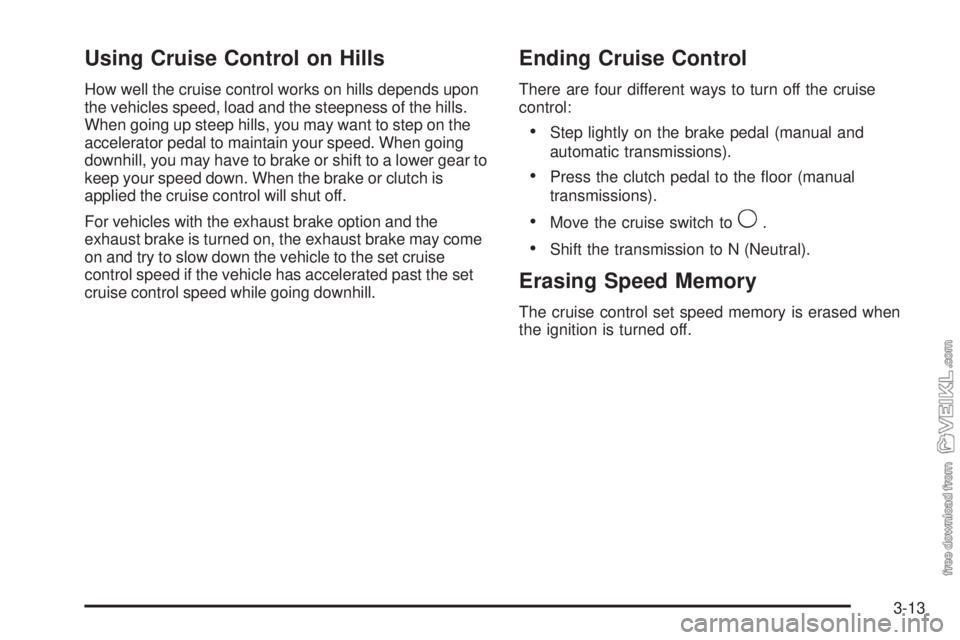
Using Cruise Control on Hills
How well the cruise control works on hills depends upon
the vehicles speed, load and the steepness of the hills.
When going up steep hills, you may want to step on the
accelerator pedal to maintain your speed. When going
downhill, you may have to brake or shift to a lower gear to
keep your speed down. When the brake or clutch is
applied the cruise control will shut off.
For vehicles with the exhaust brake option and the
exhaust brake is turned on, the exhaust brake may come
on and try to slow down the vehicle to the set cruise
control speed if the vehicle has accelerated past the set
cruise control speed while going downhill.
Ending Cruise Control
There are four different ways to turn off the cruise
control:
•Step lightly on the brake pedal (manual and
automatic transmissions).
•Press the clutch pedal to the floor (manual
transmissions).
•Move the cruise switch to9.
•Shift the transmission to N (Neutral).
Erasing Speed Memory
The cruise control set speed memory is erased when
the ignition is turned off.
3-13
Page 178 of 376
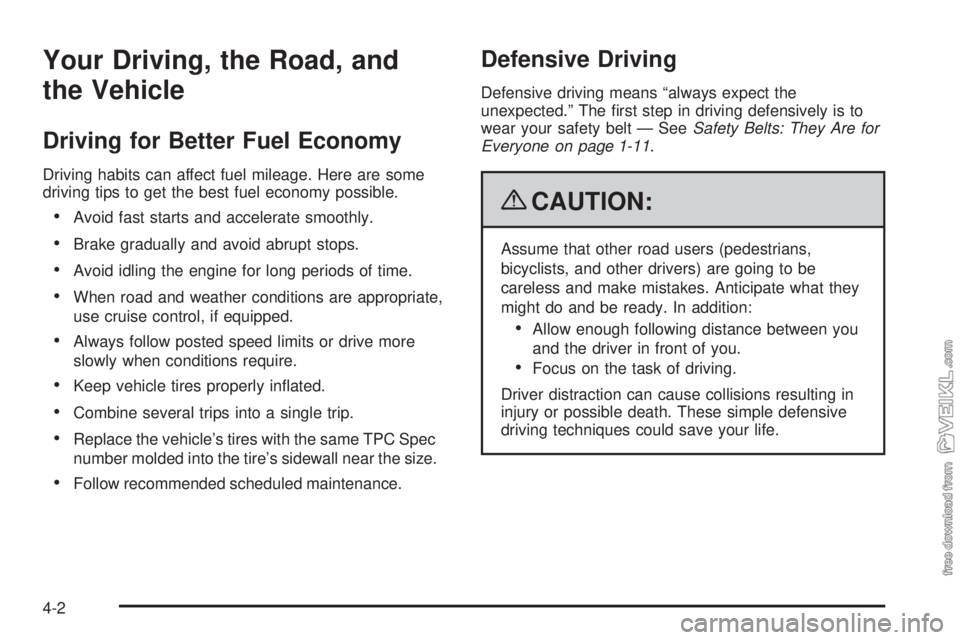
Your Driving, the Road, and
the Vehicle
Driving for Better Fuel Economy
Driving habits can affect fuel mileage. Here are some
driving tips to get the best fuel economy possible.
•Avoid fast starts and accelerate smoothly.
•Brake gradually and avoid abrupt stops.
•Avoid idling the engine for long periods of time.
•When road and weather conditions are appropriate,
use cruise control, if equipped.
•Always follow posted speed limits or drive more
slowly when conditions require.
•Keep vehicle tires properly inflated.
•Combine several trips into a single trip.
•Replace the vehicle’s tires with the same TPC Spec
number molded into the tire’s sidewall near the size.
•Follow recommended scheduled maintenance.
Defensive Driving
Defensive driving means “always expect the
unexpected.” The first step in driving defensively is to
wear your safety belt — SeeSafety Belts: They Are for
Everyone on page 1-11.
{CAUTION:
Assume that other road users (pedestrians,
bicyclists, and other drivers) are going to be
careless and make mistakes. Anticipate what they
might do and be ready. In addition:
•Allow enough following distance between you
and the driver in front of you.
•Focus on the task of driving.
Driver distraction can cause collisions resulting in
injury or possible death. These simple defensive
driving techniques could save your life.
4-2
Page 191 of 376
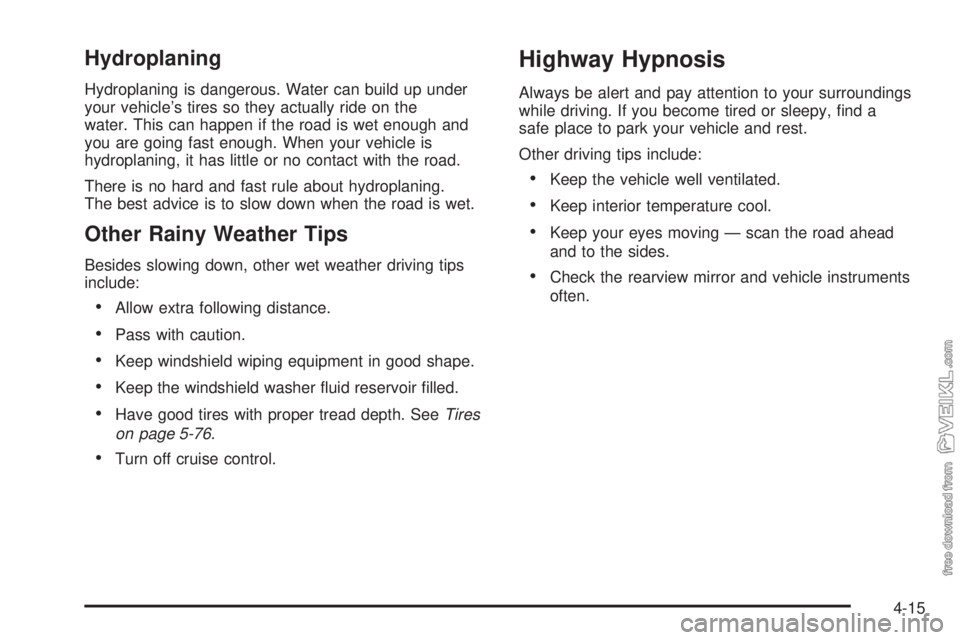
Hydroplaning
Hydroplaning is dangerous. Water can build up under
your vehicle’s tires so they actually ride on the
water. This can happen if the road is wet enough and
you are going fast enough. When your vehicle is
hydroplaning, it has little or no contact with the road.
There is no hard and fast rule about hydroplaning.
The best advice is to slow down when the road is wet.
Other Rainy Weather Tips
Besides slowing down, other wet weather driving tips
include:
•Allow extra following distance.
•Pass with caution.
•Keep windshield wiping equipment in good shape.
•Keep the windshield washer fluid reservoir filled.
•Have good tires with proper tread depth. SeeTires
on page 5-76.
•Turn off cruise control.
Highway Hypnosis
Always be alert and pay attention to your surroundings
while driving. If you become tired or sleepy, find a
safe place to park your vehicle and rest.
Other driving tips include:
•Keep the vehicle well ventilated.
•Keep interior temperature cool.
•Keep your eyes moving — scan the road ahead
and to the sides.
•Check the rearview mirror and vehicle instruments
often.
4-15